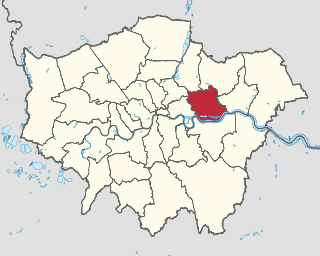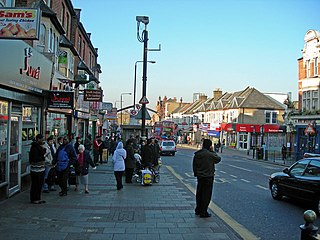
The London Borough of Newham is a London borough formed from the former Essex county boroughs of West Ham and East Ham, within east London, the name being a portmanteau word reflecting its creation while combining the compass points of the old borough names.

St Michael Paternoster Royal is a church in the City of London. The original building, which was first recorded in the 13th century, was destroyed in the Great Fire of London in 1666. The church was rebuilt under the aegis of Sir Christopher Wren. However St Michael’s was severely damaged during the London Blitz in the Second World War. It was restored between 1966 and 1968.

St Mary's Church is a Church of England church in Plaistow, east London. With the three churches of St Matthias’, St Martin’s, and St Philip and St James’, it now forms part of the Parish of the Divine Compassion. Its Victorian building is now demolished and it worships in a smaller church built in 1981.

St Paul's Church, East Ham or St Paul's Church, Burges Road is a Church of England parish church in East Ham, Newham, east London.
St John the Baptist's Church, East Ham, was a Church of England church dedicated to St John the Baptist in East Ham, east London. It was built in 1866 as a chapel of ease to St Mary Magdalene's Church, then still the main parish church for the area. In 1902 it was converted into a church hall for the new church of St Bartholomew's and in 1925 it was demolished.
St Bartholomew's Church, East Ham is a Church of England church on Barking Road in East Ham, east London dedicated to Bartholomew the Apostle.

St George and St Ethelbert's Church, East Ham, is a Church of England church in East Ham, east London.
All Saints Church, East Ham is a Church of England church in East Ham, east London. It was set up around 1880 in an iron mission church to meet the development of the Woodgrange Estate. This was replaced by a parish of its own with a permanent church in the Early English style on Romford Road in 1886.
St Edmund's Church, Forest Gate or the Church of St Edmund, King and Martyr, Forest Gate is an Anglo-Catholic church in the Forest Gate area of Newham, east London. It is dedicated to Edmund the Martyr. It originated in 1895 as the Red Post Lane mission district of All Saints parish. It became a parish of its own in 1901, with a permanent church completed in 1932. It now forms part of the East Ham Team Parish alongside St Mary Magdalene's Church, St Bartholomew's Church and St Alban's Church.
St Stephen's Church, East Ham, was a church on Green Street in East Ham, east London. Its nave and aisles were completed in 1887 and its chancel, north chapel, south chancel aisle, vestries and choir in 1894. It founded three mission churches - St Alban's Church, St Michael's Church, Rutland Road and St Cuthbert's Church, Florence Road.
St Alban's Church, Upton Park is a Church of England church in the Upton Park area of East Ham in east London, England, dedicated to Saint Alban. It was founded by St Stephen's Church as a mission church on Boleyn Road in the Upton Park area around 1889, replaced by a small brick church on Wakefield Street in 1897. It was given a parish of its own in 1903, in which year the nave and aisle of a new permanent church on the opposite side of the same street were completed. Vestries, a Lady Chapel and chancel were added in 1934. Damaged by the London Blitz in 1940, it was repaired in 1949 and now forms part of the East Ham Team Parish alongside St Mary Magdalene's Church, St Bartholomew's Church and St Edmund's Church.
St Michael's Church, Rutland Road is a church in East Ham, east London, originally built for the Church of England. It was established as a mission church of St Stephen's Church, East Ham in 1895, with services held in Saxby Villas, Red Post Lane until the completion of a temporary iron church in 1898. In 1912 a permanent church was built. This housed the congregation of St Stephen's after that church was damaged by bombing in 1940 and after that parish was dissolved in 1953 St Michael's was instead attached to St Edmund's Church. It closed as an Anglican church in 1971 and now houses a Romanian Orthodox church.

St Matthew's Church, Custom House was a Church of England church on Ethel Road in the Victoria Docks area of West Ham. It is named after its district, Custom House.

The Church of the Ascension, West Ham or Church of the Ascension, Victoria Docks is a Church of England church on Baxter Road in West Ham, east London. It was first built in 1887 as a mission hall for St Luke's Church, later put under the charge of the Felsted School Mission, which prior to that had been working in Bromley. Between 1903 and 1907 a new church was built, with a separate parish split from St Luke's in 1905. The new parish opened a mission house for women workers in 1909.

St Andrew's Church was a Church of England church on Barking Road in Plaistow, east London. It began as a small mission built in 1860 on Whitwell Road by St Mary's Church, Plaistow. A permanent church designed by James Brooks opened in 1870 on a site just south of the northern outfall sewer embankment and a separate parish assigned to it the following year. A large central crossing tower with a pyramidal spire was planned but only completed as far as the ridge of the nave roof.
St Gabriel's Church, Canning Town was a Church of England church in Canning Town, east London. It originated as an undedicated iron church between the River Lea and the railway to the north of the Barking Road, on the site later used for the brick-built permanent church of St Gabriel's, consecrated in 1876. Initially a mission of All Saints Church, West Ham, it was given a parish of its own three years after the consecration, using parts of those of All Saints, St Mary's and St Andrew's. It was damaged in the London Blitz and demolished around 1955, with its parish split between St Matthias and St Luke's in 1961.
St Peter's Church was a Church of England church on Upton Lane in the Upton Cross area of Newham, East London. Its origins were in a mission of St Mary's Church, Plaistow on Pelly Road, holding services in a barn then in an iron church. Joseph Lister's former home Upton House was bought by the bishop of St Albans in 1885, becoming the vicarage, whilst its garden provided the site for a permanent church, built in 1893 and given a separate parish the following year using parts of those of All Saints, St Mary's, Emmanuel and St Stephen's. The parish was merged into that of Emmanuel in 1962 - the church was left standing as a chapel of ease to Emmanuel, but its vicarage was demolished, the site being sold in 1968. Funds from that sale and the sale of the parish hall were intended for a new church, church hall and clergy house, but in 1972 St Peter's Church was declared redundant, demolished and its site sold off, leading to the scheme's abandonment three years later.
St Barnabas' Church, West Silvertown was a Church of England church in Silvertown, east London. It was opened in 1882 on Eastwood Road as a mission church of St Mark's Church, Silvertown. In the 1917 Silvertown explosion its chancel and iron hall were destroyed, leaving the church to use temporary buildings until the completion of a new church and the formation of a separate parish for it, both in 1926. The new parish was mainly drawn from St Mark's, though it also took a small part of the parish of St Luke's Church, Canning Town. The vicar of St John's Church, North Woolwich administered it after 1945. The parishes of St John, St Mark and St Barnabas were merged in 1974 to form the parish of North Woolwich with Silvertown.
St Cedd's Church was a Church of England church between Newham Way, and Chadwin Road, in Canning Town, east London, dedicated to Cedd, evangelist to Essex, in whose ceremonial county the church falls. Opened as a brick hall in 1903-1904 as a mission of St Andrew's Church, Plaistow, it had a mission district assigned using parts of the parishes of St Andrew's and St Luke's in 1905. That mission district was turned into a separate parish in 1936, for which a new redbrick church was completed in 1939. Part of the former parish of Holy Trinity Church was assigned to St Cedd's in 1961, though the latter is no longer an Anglican church. Fire damaged in 1995, it was restored and re-opened in 2007 to house the London Ghana Seventh-day Adventist congregation











